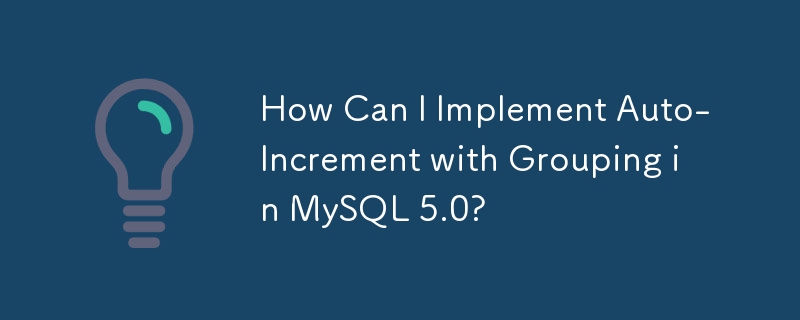How Can I Implement Auto-Increment with Grouping in MySQL 5.0?
Oct 27, 2024 pm 11:33 PM
Auto-Increment with Grouping in MySQL (5.0)
When working with relational databases, it can be beneficial to have an auto-increment field that is grouped by a specific column. This can provide a sequential order within each group, making data manipulation and analysis more efficient.
In MySQL version 5.0, there is a method to achieve auto-increment by group using MyISAM or BDB table types. By creating a secondary part of the primary key as an auto-increment field, you can ensure that the auto-increment value is unique within each group.
Structure:
<code class="sql">CREATE TABLE foo ( id INT AUTO_INCREMENT NOT NULL, group_field INT NOT NULL, name VARCHAR(128), PRIMARY KEY(group_field, id) );</code>
Explanation:
- group_field: Column used to group the data.
- id: Auto-increment field that will have unique values within each group but is not unique across all rows in the table.
The auto-increment value is calculated as follows:
MAX(id) + 1 WHERE group_field=given-group
This ensures that when inserting new records into the table, the id field will automatically increment within the specified group.
The above is the detailed content of How Can I Implement Auto-Increment with Grouping in MySQL 5.0?. For more information, please follow other related articles on the PHP Chinese website!

Hot Article

Hot tools Tags

Hot Article

Hot Article Tags

Notepad++7.3.1
Easy-to-use and free code editor

SublimeText3 Chinese version
Chinese version, very easy to use

Zend Studio 13.0.1
Powerful PHP integrated development environment

Dreamweaver CS6
Visual web development tools

SublimeText3 Mac version
God-level code editing software (SublimeText3)

Hot Topics
 Reduce the use of MySQL memory in Docker
Mar 04, 2025 pm 03:52 PM
Reduce the use of MySQL memory in Docker
Mar 04, 2025 pm 03:52 PM
Reduce the use of MySQL memory in Docker
 How do you alter a table in MySQL using the ALTER TABLE statement?
Mar 19, 2025 pm 03:51 PM
How do you alter a table in MySQL using the ALTER TABLE statement?
Mar 19, 2025 pm 03:51 PM
How do you alter a table in MySQL using the ALTER TABLE statement?
 How to solve the problem of mysql cannot open shared library
Mar 04, 2025 pm 04:01 PM
How to solve the problem of mysql cannot open shared library
Mar 04, 2025 pm 04:01 PM
How to solve the problem of mysql cannot open shared library
 Run MySQl in Linux (with/without podman container with phpmyadmin)
Mar 04, 2025 pm 03:54 PM
Run MySQl in Linux (with/without podman container with phpmyadmin)
Mar 04, 2025 pm 03:54 PM
Run MySQl in Linux (with/without podman container with phpmyadmin)
 What is SQLite? Comprehensive overview
Mar 04, 2025 pm 03:55 PM
What is SQLite? Comprehensive overview
Mar 04, 2025 pm 03:55 PM
What is SQLite? Comprehensive overview
 Running multiple MySQL versions on MacOS: A step-by-step guide
Mar 04, 2025 pm 03:49 PM
Running multiple MySQL versions on MacOS: A step-by-step guide
Mar 04, 2025 pm 03:49 PM
Running multiple MySQL versions on MacOS: A step-by-step guide
 How do I secure MySQL against common vulnerabilities (SQL injection, brute-force attacks)?
Mar 18, 2025 pm 12:00 PM
How do I secure MySQL against common vulnerabilities (SQL injection, brute-force attacks)?
Mar 18, 2025 pm 12:00 PM
How do I secure MySQL against common vulnerabilities (SQL injection, brute-force attacks)?
 How do I configure SSL/TLS encryption for MySQL connections?
Mar 18, 2025 pm 12:01 PM
How do I configure SSL/TLS encryption for MySQL connections?
Mar 18, 2025 pm 12:01 PM
How do I configure SSL/TLS encryption for MySQL connections?







